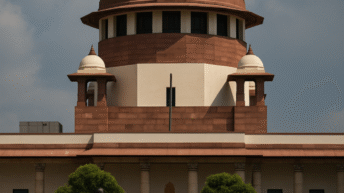
The detention of Arundhati Roy under the Unlawful Activities (Prevention) Act (henceforth UAPA) has sparked a heated debate about the boundaries of free speech and the preservation of democratic principles in India. Arundhati, as a matter of fact, a vocal critic of the government’s policies and an activist for human rights causes, has long been a polarising figure, attracting both ardent supporters and vehement detractors. While her critics argue that her statements and actions amount to sedition and a threat to national security, her defenders contend that her detention is a blatant infringement on the fundamental rights enshrined in the Indian Constitution.
Her admirers’ blind support evokes the old story of the ‘Pied piper of Hamelin’ who was followed by many rats. Moreover, the central premise is to examine the nuances of this complex issue by exploring the legal frameworks, historical contexts, and philosophical underpinnings that shape the discourse around civil liberties and national security. By scrutinising the specific charges against Roy and the provisions of the UAPA, this analysis will argue that her detention is not inherently against democratic principles. Instead, this arrest represents a balancing act between the Constitutional rights and ‘reasonable restriction’ (including maintaining Unity & Integrity, and public order) enshrined in the Constitution. From many past events, Arundhati perhaps forgets the existence of ‘reasonable restriction’ in every fundamental right, and she only upholds the freedom of speech and expression, which undoubtedly makes her a half-hearted democrat. There are some scorching questions about her role which she intentionally ignored and she can be accused of misleading the nation, specifically the youth, through her writings and public addresses in universities, and other significant public forums.
Arundhati Roy has been an outspoken critic of the Indian government’s policies in Kashmir and a vocal supporter of the separatist movement led by groups like the Hurriyat Conference. In her writings and speeches, she has painted a picture of India as an ‘Oppressive State’ occupying Kashmir by force. She has seemingly justified the militancy and violence of separatist groups as an inevitable reaction to this oppression. Her rhetoric often demonises the Indian military’s presence in Kashmir, accusing them of human rights abuses and portraying their actions as exercises of sheer brutality against innocent civilians. Roy seems to overlook or diminish the genuine threat of cross-border terrorism that the security forces are trying to contain. She fails to acknowledge the role of Pakistan-backed terrorist groups like Lashkar-e-Taiba and Jaish-e-Mohammed in fomenting violence and unrest in the valley.
By lending overt support to the separatist movement and to the demands for “azadi” (freedom) from India, she disregards the fact that a significant portion of the Kashmiri population wants to remain a part of the Indian union (not to mention the Kashmiri Hindus who were forced into exile in other parts of India and abroad but who have a legitimate right to return to their land of origin). Her writings present a lopsided, one-dimensional view that delegitimises the region’s democratically-elected state governments and the pro-India voices. Critics argue that she romanticises and even glorifies the separatist struggle, choosing to disregard the fundamentalist ideologies and human rights violations committed by some militant outfits. Her sympathies lie more with the separatist cause than with the welfare and aspirations of the Kashmiri people themselves, a majority of whom want peace and economic development. There are also concerns that Arundhati’s rhetoric, which is often hyperbolic and provocative, could inflame passions and misinform people about the complex ground realities in Kashmir. By portraying the Indian state as solely culpable and the separatists as freedom fighters, she creates further polarisation and mistrust, detrimental to peaceful dialogue and can prevent a resolution of the Kashmir issue.
The Charges and Legal Framework
Arundhati’s detention was carried out under Sections 13 (punishment for unlawful activities) and 18 (punishment for conspiracy) of the UAPA, which criminalises illegal activities aimed at secession or at disrupting India’s sovereignty and territorial integrity. The specific allegations against her include making inflammatory statements and advocating for the secession of Kashmir from India, actions that the government claims could incite violence and undermine national security.
The UAPA, enacted in 1967 and subsequently amended multiple times, is a controversial piece of legislation often criticised for its broad and vague provisions which, civil liberties advocates argue, can be misused to stifle dissent and curtail fundamental freedoms. However, it is essential to note that the act is not unique to India; many democratic nations have similar laws to counter threats to national security and maintain public order. The crux of the issue lies in striking a balance between the freedom of expression, a cornerstone of any democratic society, and the need to protect the nation’s integrity and the safety of its citizens. The Indian Constitution, in Articles 19(1)(a) and 19(2), explicitly recognises the right to freedom of speech and expression but also provides reasonable restrictions on this right in the interest of sovereignty and integrity, public order, and security.
Historical Context and Precedents
The debate around civil liberties and national security is not new to India or unique to her case. Throughout its post-independence history, India has grappled with numerous instances where the government has employed stringent laws to curb dissent and maintain public order, often drawing criticism from civil society and human rights organisations. One of the most notable examples is the Emergency imposed by Prime Minister Indira Gandhi in 1975, during which civil liberties were suspended, and dissenting voices were suppressed allegedly for the sake of national security. The infamous Maintenance of Internal Security Act (MISA) was used to detain thousands of political opponents and critics, a dark chapter in India’s democratic history that serves as a cautionary tale against the unchecked erosion of civil liberties.
However, it is essential to recognise that Arundhati’s case operates within a different context and legal framework. The UAPA, allegedly controversial, has been upheld by the Indian judiciary as a necessary tool to combat unlawful activities that threaten the nation’s integrity and security. In the landmark case of Arup Bhuyan vs. the State of Assam (2011), the Supreme Court upheld the constitutional validity of the UAPA, stating that the restrictions imposed by the act were reasonable and necessary to maintain public order and national security. Furthermore, there are numerous precedents where the Indian courts have balanced the right to freedom of expression with the need to maintain public order and national security. In the case of Kedar Nath Singh vs. the State of Bihar (1962), the Supreme Court held that speech that incites violence or creates public disorder can be curtailed by reasonable restrictions. Similarly, in the case of S. Rangarajan vs. P. Jagjivan Ram (1989), the court ruled that freedom of expression could be limited if the expression threatens public order or the sovereignty and integrity of India.
Philosophical Underpinnings and Democratic Principles
At the core of this debate lies a fundamental philosophical question: what constitutes the boundaries of free speech in a democratic society, and how do we reconcile the potential tensions between individual liberties and collective security? Proponents of absolute and unrestricted freedom of expression argue that any form of censorship or curtailment of speech is antithetical to the very essence of democracy. They contend that even the most controversial or inflammatory speech should be protected, as the free exchange of ideas is crucial for the growth and progress of a society. This perspective is rooted in the belief that the marketplace of ideas will ultimately prevail and that truth and reason will triumph over falsehoods and extremism.
However, others argue that while freedom of expression is a cherished democratic value, it cannot be an absolute and unbridled right. They assert that speech that incites violence threatens national security, or undermines the state’s foundations must be subject to reasonable restrictions. This view is grounded in the belief that the preservation of public order and the collective security of a nation is a prerequisite for the enjoyment of individual liberties, including the freedom of expression.
Arundhati’s detention often invokes the philosophical principle of “clear and present danger,” which originated in the United States and held that speech can be curtailed if it poses an imminent threat of unlawful action or violence. Her statements and advocacy for secession cross the line from the mere expression of dissent into incitement, posing a tangible threat to India’s territorial integrity and public order. On the other hand, the Pied Pipers’ rats (her admirers) contend that her statements, no matter how controversial or provocative, fall well within the bounds of protected speech. They assert that her advocacy for self-determination and her criticism of government policies, while unpopular or even offensive to some, do not directly incite violence or pose an immediate danger to the nation. They view her detention as a suppression of dissent and a violation of the democratic principles enshrined in the Indian Constitution. Unfortunately, the rats are under a hypnotic spell. They are falling from the cliff, and the pied piper is still enjoying this lunatic controversy because she has lost her sense of balance by ignoring the fact that in any society, however democratic, there are limits to the expressions of dissent against the state.
Lastly, while divisive, Arundhati’s detention under the UAPA does not inherently violate the democratic principles that underpin India’s constitutional framework. The charges against her, while subject to legal scrutiny and debate, are grounded in laws upheld by the Indian judiciary. However, it is crucial to acknowledge that such rules must be reasonable and carefully balanced against the fundamental right to freedom of expression.
Ultimately, the actual test of democracy lies not in the absence of controversy or dissent but in its ability to navigate the inherent tensions between individual liberties and collective security through robust legal frameworks, independent institutions, and a commitment to the principles of justice, equality, and freedom. Arundhati’s case, while contentious, reminds us that upholding democratic principles is a delicate balancing act, one that requires constant vigilance, open discourse, and a willingness to confront complex questions poised at the intersection of rights and responsibilities. Thus, it proves that no one is above the law but that all are equal before the law.






Add comment